I joined Amplitude three years ago, and my role was to start out their first product growth team. But at the time, I quickly realized that there’s so little literature out there about how you're supposed to do this, how to think about where this team should sit in an organization, and how to build out the team.
Where should this team initially focus? And as the team scales, where do you hire the best growth people out there?
So today, I’m excited to share some of my personal experience with scaling out the growth team at Amplitude. I also consulted a couple of top growth professionals that have scaled hypergrowth companies in both consumer and enterprise spaces, such as Airtable, Eventbrite, and Pinterest, so I'll be sharing some of the key learnings from structuring a growth team at those companies as well.
I'm first going to share what a growth team does. Believe it or not, even though growth is such a commonplace function, it's still very much an emerging domain, so I want to level set on what the job of the growth team is.
Then I’ll be talking about when you actually need a growth team because there's such a thing as spinning out the growth team too early or even too late in your company's growth trajectory.
I’ll spend most of my time talking about growth team structure and/or design, and I'll be sharing some concrete examples of companies out there and the pros and cons of different structures that you normally see.
And finally, we'll be talking about how you can find the best growth talent.
What does a growth team do?
Casey Winters is the former CPO of Eventbrite and the first Product Lead at Pinterest for their growth team. He has a great definition of what the core job of a growth team is:
“Most product teams are built to create or improve the core value provided to customers. Growth is connecting more people to the existing value.”
What's important here is that growth teams don't tend to build new features, that's the job of the core product teams. However, the growth team's mission is incredibly important; it is to distribute the existing value of your product to as many potential customers as possible, and remove all friction along the way to help them experience the value as easily and quickly as possible.
How it manifests inside an organization like Amplitude is that we define our growth team’s charter as building a predictable, sustainable, and competitively defensible distribution strategy.
This team's goal is to drive long-term, sustainable growth for Amplitude. While you might think of a growth team as helping a company achieve short-term, revenue growth, or user growth targets, this team should also be thinking long-term about what the foundations and building blocks are that they should be starting to work on, so that business grows as sustainably and competitively as possible.
How a growth team functions is also fundamentally very different from how a core product team or a traditional marketing team functions.
Below is a framework from Reforge, a professional development program for growth and product professionals. It lays out three fundamental ways that a growth team operates that might be different from some of the other teams.
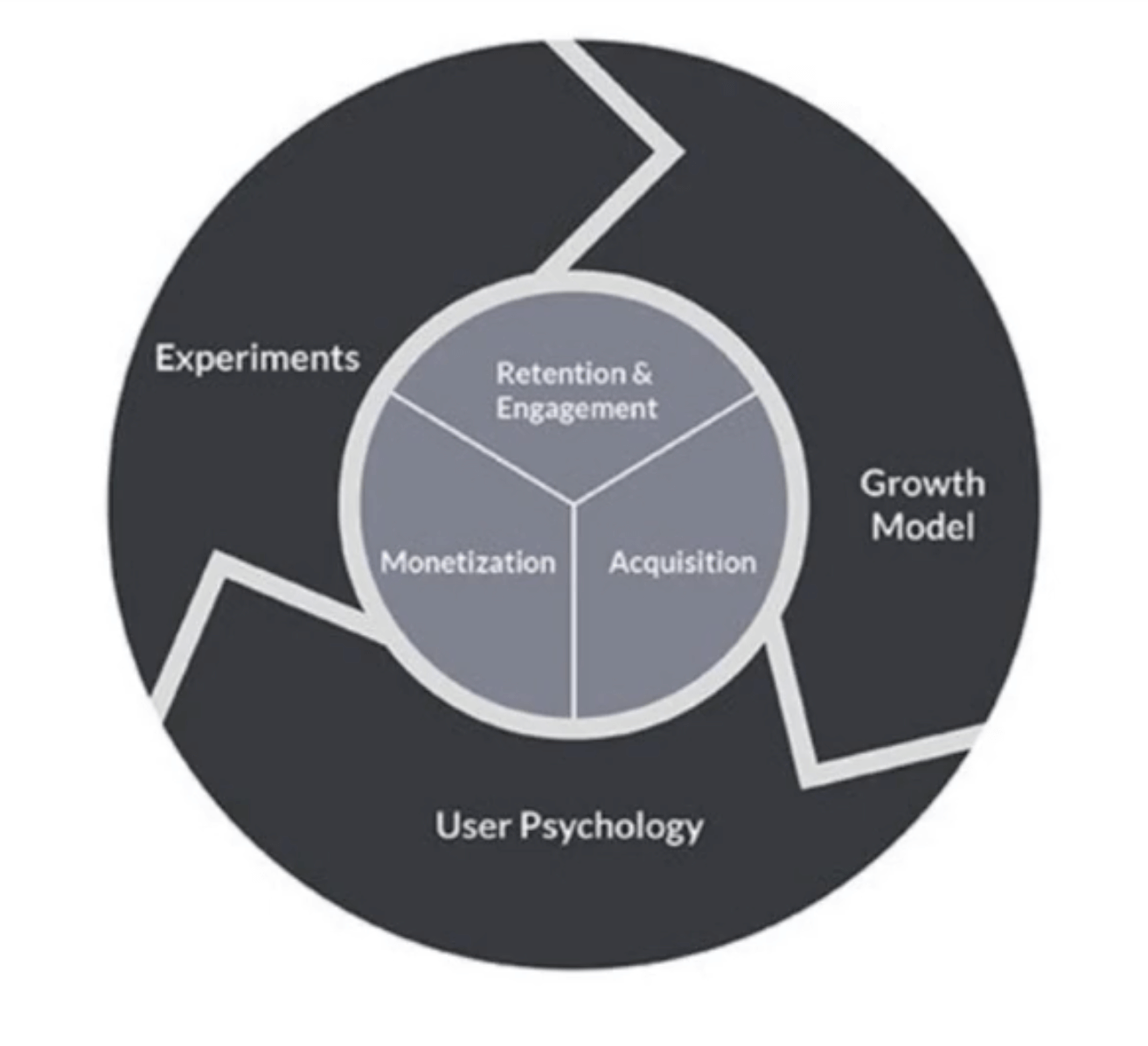
First of all, a growth team should be laying out the growth model for a business. They should both quantitatively and qualitatively think about how your business is acquiring, retaining, and monetizing customers. By doing this, you should have a fundamental view of what the most important levers in your company are that drive your growth, whether you’re a product-led, marketing-led, or sales-led organization.
This is incredibly important for a growth team because this is how they can identify what the biggest points of leverage are, and the needles they should be investing time into to move the business forward.
Secondly, the growth team should be an expert on user psychology. Even though it's a very data-driven, analytical team, they should deeply understand the customers' personas and pain points so that they can brainstorm the types of initiatives that will move the needle on driving growth.
And then finally, this is a team that often leverages hypotheses-driven experimentation to test different hypotheses, validate them, and have a quantifiable impact on some of your key metrics.
One of the first questions that might come to mind when you're thinking about dedicating more resources to a growth team is, what should this team be working on?
I asked many of the growth practitioners about what the early focus of their growth team was when it just got started. And there’s actually a surprising amount of convergence in terms of the initial area of focus that the first growth team tends to focus on.
They tend to start with acquisition and activation problems. For example, at Amplitude, our first growth team started working on growth traffic. Essentially, the KPI is to drive net new signups to our free product, and this team worked a lot on the web conversion and the startup scholarship program to attract more SMBs early on with a freemium motion.
At Lyft, their growth team initially focused on paid acquisition, but they were also starting to improve driver onboarding to improve the activation of new drivers.
At Patreon, their first growth team started with creator onboarding. At Eventbrite, their growth team was focused on event creator growth at the very beginning.
So this seems to be a common trend among all the growth teams that I’ve chatted with in terms of where they started. But you might be wondering why, because there are also other growth problems to tackle such as monetization, retention, and engagement.
My personal take on why growth teams don't tend to start by tackling retention is if your product is experiencing a severe retention problem, that’s probably a signal that there’s some issue with product market fit, or there’s a mismatch of who you're acquiring top of the funnel and to the core value prop that’s being delivered with your core product.
So if your product hasn't even reached product-market fit yet, the typical advice that we would give is that it’s too early to deploy a growth team to tackle that problem. You might be better off spending more core product development resources to make sure you build a solid core product experience that actually has product-market fit.
The reason why growth teams don't tend to start with monetization is that you need to have a large enough user base so that your monetization efforts can yield the most impact.
In terms of long-term ROI, it's logical sequencing to focus on acquisition activation first, to make sure that you grow your entire user base and that you don't have a severe activation issue. And then, later on, layer in some monetization improvements so that those efforts can have the highest ROI.
When do you need a growth team?
Out of 100 companies that you might see on the market today, only a minority of them have already established a growth team. And yet, a lot of the early-stage founders and those that are still in the seed or Series A stage are already starting to think about hiring a head of growth or a dedicated growth team.
So when is the right time for a company to start thinking about establishing a dedicated growth team?
Lauryn Isford, the Head of Growth at Airtable, has a great take on this topic. She says:
“Many companies want to establish a growth team too early. Growth teams should scale product market fit. When you're first launching, you could have a growth hire to drive acquisition, signups, SEO. You may be making one hire to seed initial viral loops. When you want to establish a team, you should already have figured out a loop. So you should start with one team to figure out where the loops are.”
The most critical takeaway here is that a growth team should come in after a company has already found product-market fit. And that’s why my usual advice to seed-stage founders is that when you're not even sure you have product market fit yet, it's probably a little bit too early to be thinking about having a dedicated team focusing on growth.
Another important takeaway from this is that it's really important to figure out the levers of your growth before you deploy a team against it. So there’s some foundational understanding of the business that the existing team should already have done so you know what type of talent you need.
This leads to Elena Verna’s advice. Elena is the Interim VP of Growth at Amplitude. She advises that:
“Companies should have a basic view of their growth model before deciding to hire a growth team so that they can hire the right type of talent.”
What she means is that you need to make sure you have a good understanding of whether you’re a product-led, marketing-led, or sales-led company. It's not the right match if you’re a marketing or sales-led organization and you bring on someone with a gross product management background. Their background isn’t the right fit in terms of the predominant growth motion of your business.
Furthermore, in order to establish this growth model, you need to have some foundational data to be able to analyze your different growth levers. So investing very early in your growth and data infrastructure is really important so that you can have that understanding as early as possible and get ready for a growth team to come in, re-examine, and accelerate that growth.
How to structure a growth team
At this point you’ve hopefully already thought about how growth is really important to the company, you’ve already figured out your go-to-market motion, and have a clear point of view on how to grow as a business. And there’s also buy-in from the executive and leadership levels to invest further in growth.
So the next question is, where should this team sit? And how should we approach the org design so that this team can have the maximum amount of impact?
I'm going to walk you through several common archetypes of org designs that I've seen across different companies, and also discuss the pros and cons of each structure, because no structure is perfect.
The first org structure that is typically seen is a centralized growth org where you have a growth executive. You could take the title of VP of Growth or a Chief Growth Officer who reports directly to the CEO. And that person sits in parallel with your Chief Product Officer, Chief Marketing Officer, and CTO.
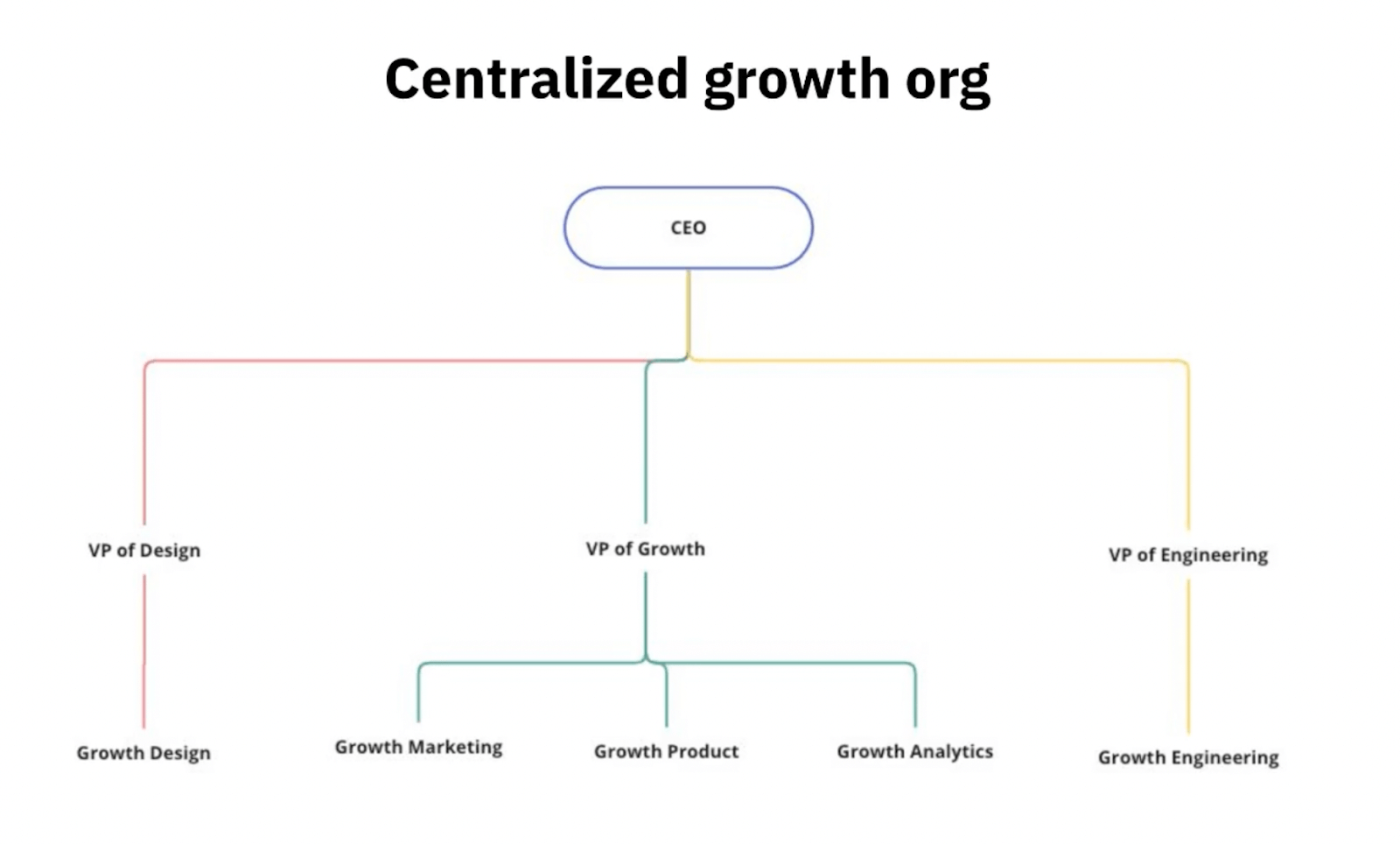
In this model, you’d have people working on growth, especially in those business functions such as growth marketing, growth product, and growth analytics reporting to this growth executive.
Even in the centralized growth organization, growth engineering still typically reports to the CTO. It's less common to see growth engineering reporting to a VP of Growth, but at Dropbox, growth engineering reported to the VP of Growth because that growth executive came from an engineering leadership background.
A lot of the nuance also comes from what type of competency and background your growth talent has within the organization that would guide some of the placement of the specific functions inside the company.
When we think about the pros and cons of this structure, when you put cross-functional talent that’s all working on growth and driving the same set of metrics and OKRs under the same executive, it can help significantly with cross-functional alignment and velocity.
Because this growth executive is usually empowered and entrusted with independent decision-making, there might be less dependency on adjacent departments and executives. Also, having a very senior executive sponsor can help address a lot of the cross-functional dependencies and alignment more easily.
The con of this structure is that while you may have velocity and this team might be able to make changes really fast, they might not have as much interaction with the rest of their function and department as they otherwise would.
You might encounter another issue of this growth mindset being isolated to this independent growth team. As the rest of your product and marketing teams don't have day-to-day interactions with the growth team, they might not benefit from learning about the way this team works and how to approach experimentation, so there could be a dissemination of this growth mindset issue.
When companies aren’t satisfied with this model, they usually consider an alternative model, which is the growth tribe model.
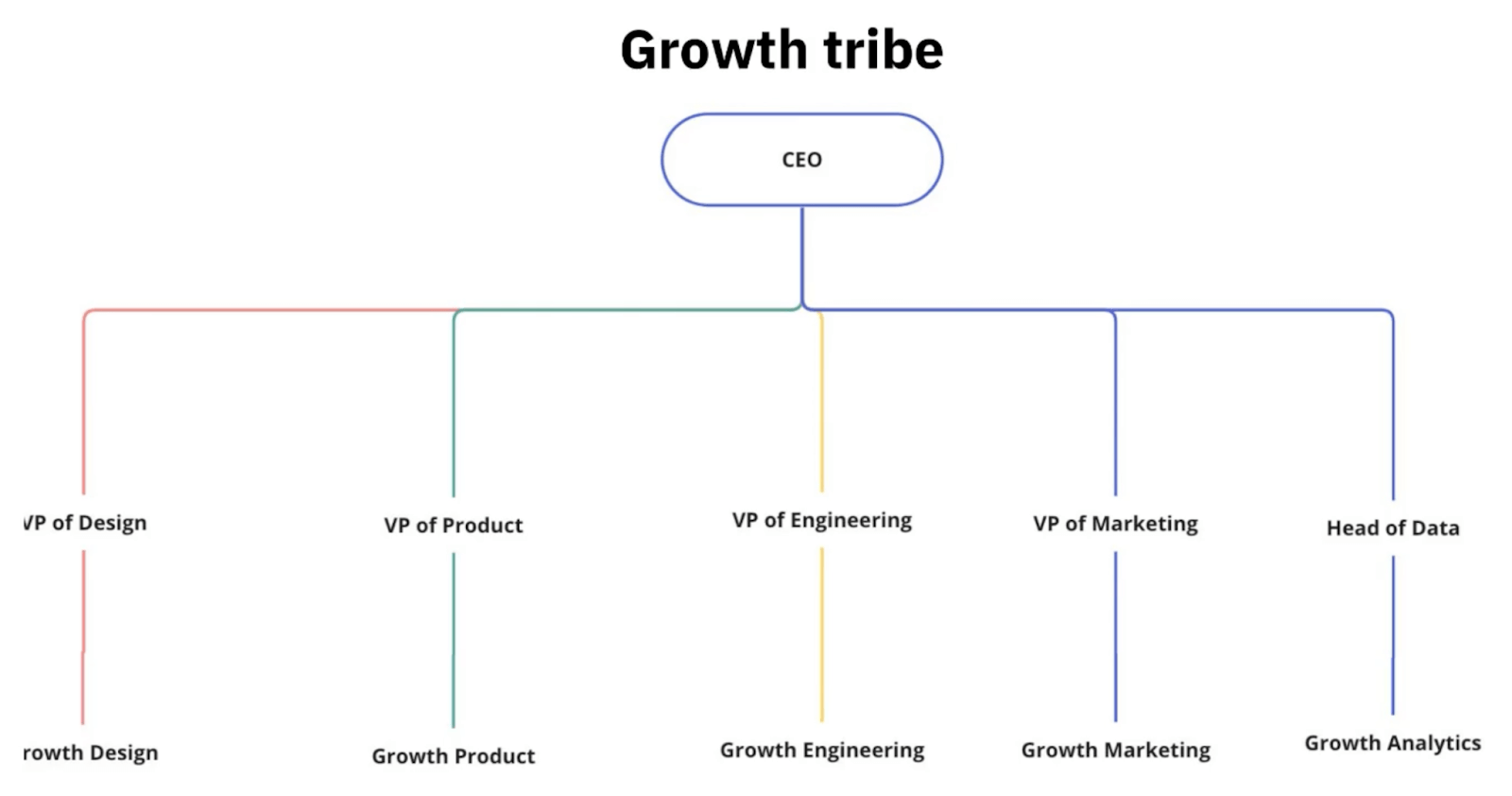
In this model, you’d have the people working on growth rolling up to their respective functions. So the growth product team reports to the VP of Product, growth marketing reports to the VP of Marketing, etc.
Pinterest is one of the companies that pioneered this kind of growth tribe structure, and it has worked really well for them. The reason why it works well is that you benefit from this growth mindset culture in the organization because these growth PMs often interact with other PMs in organizations.
There might be benefits with hiring because a lot of product managers, even if they focus on growth, still want to report to the executive whom they see themselves becoming in the future, instead of being siloed and reporting to a different org that may make them feel isolated from the rest of the company.
However, there's also a con with this structure, which is the pro of the first centralized growth org structure. It’s velocity.
In this world, when you have different growth talent reporting into their own functions, there's no single executive responsible for growth. And every single time this cross-functional group wants to shape some changes, they tend to need to align a lot more with their core product team peers or other marketing teams to make sure that there’s alignment. So one of the cons of this structure is definitely velocity.
Those are two of the most common structures that we've seen, but there are also a lot of different variants based on them. For example, one slight variant from the growth tribe structure is when a CPO or CMO runs both growth product and marketing functions.
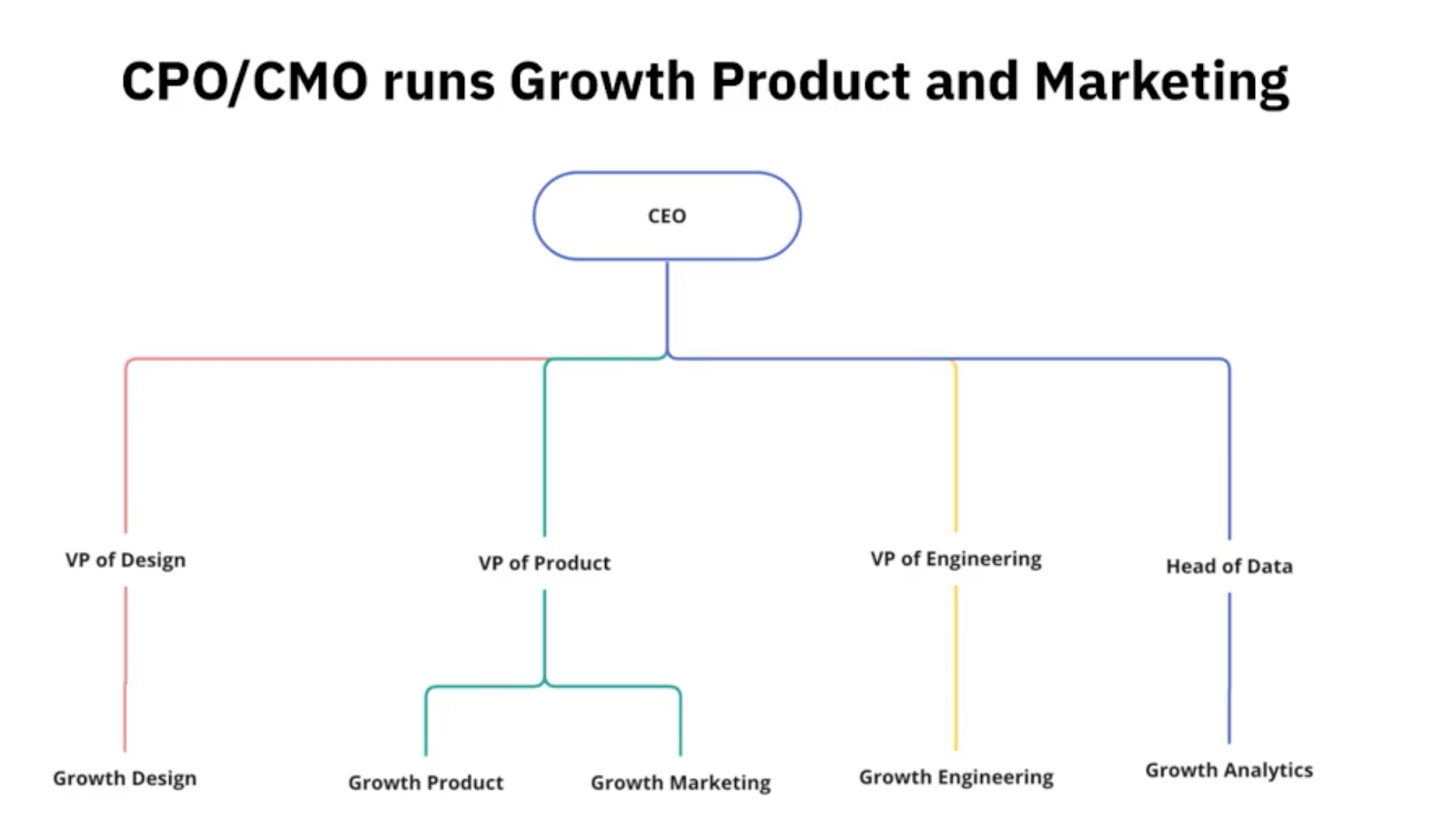
An example of this is Imperfect Foods. Adam Fishman was the Chief Product and Growth Officer at Imperfect Foods, and at one point both the growth marketing and growth product teams rolled up to him, although it later shifted and growth marketing separated out and reported back to the CMO.
But the reason why it worked for him at the time was that he’s the type of growth practitioner who had both a growth product management and growth marketing background, which isn’t common at all.
Again, in this scenario where you have an executive who has competencies across multiple domains, it makes it possible for a single executive to cross over and manage multiple functions.
There's a fourth structure that you can see at companies at Amplitude and Airtable. This is when the Chief Product Officer runs growth product, design, and analytics. Sometimes they run growth marketing as well, but those three are the common functions that roll up to the CPO.
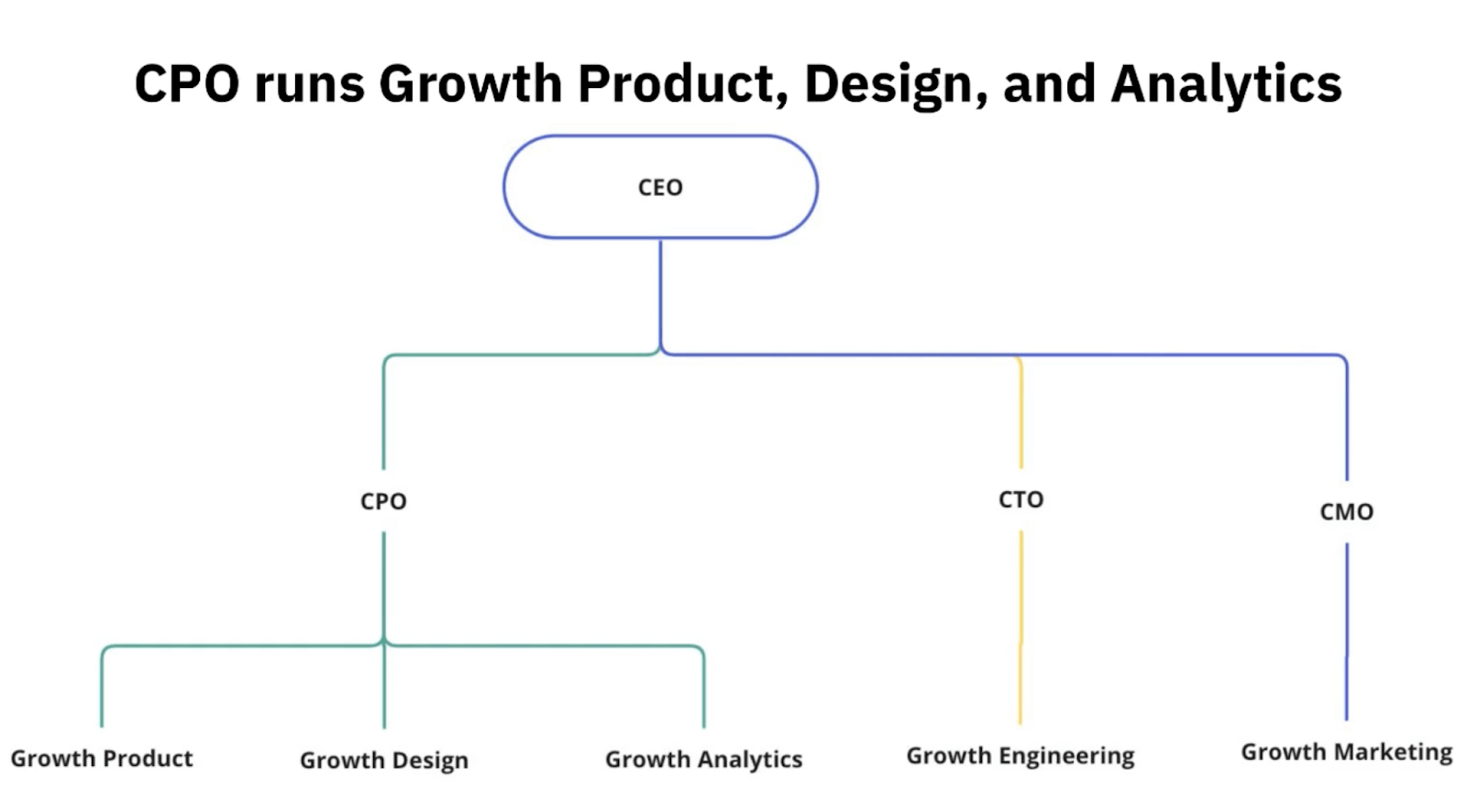
The reason why Amplitude decided to adopt this particular org structure is because our CPO has always been the primary executive championing growth at the company.
The first growth team was a growth product team, and that sat under product, even though the team's charter and mission were very much on the acquisition side and the scope of the changes were primarily on the marketing website.
Over time, as this team scaled and we added more analysts to support growth, it made sense for all of those different functions to live within the product organization.
At one point, growth marketing even rolled up to the CPO. But now we’ve decided to move growth marketing out of product and report back to the CMO because the company wanted to optimize for disseminating that growth mindset throughout the organization. So this change in org design was optimized towards making sure the rest of the marketing board also benefits from the growth mindset and culture.
So as you can see, the types of variations you could have with structuring a growth team is infinite. And often the reason why there are so many different nuances with how you could be structuring an organization really comes down to the unique circumstances of your growth model, business model, and what type of talent you have.
Fundamentally, the rule of thumb here is the right team structure depends on your understanding of your growth model. And often it could vary based on the competency of the growth leader that you already have in your company, or someone you want to bring inside a company.
How to effectively tackle growth hiring
You're now committed to hiring for growth, but the challenge is not done, because growth hiring is extremely hard.
When you think about growth as a function, it has only existed for about a decade. So the number of people out there who have been there and done that and know how to do growth is few and far between. And that makes growth hiring extremely competitive and difficult.
Let's assume you're early in your growth journey and you don't have anybody dedicated to growth at this point. How should you think about hiring the first person who is dedicated to thinking about growth?
I love this advice from Casey Winters. He said:
“You shouldn't hire someone for the first growth hire. Someone internal should do it who already has context on your business. There's no head of growth that's going to join a company if no one is currently working on growth. They want to see that you're already invested in it to know that you treat it seriously. That's the biggest mistake I see companies making when making the first growth hire.”
And his sentiment is actually echoed by almost everyone I have spoken with at other companies, because when you're just starting out on your growth journey, you actually need to have someone who already knows the business and has the trust and credibility within an organization, because growth is sometimes a brand new culture and way of working.
Sometimes internal talent works best because that person already has solid relationships across the company, whereas an outside executive who has been there and done that, although they may have experience with other types of products and business models, those learnings and frameworks don't always apply to your company's product.
But the question is, how do you identify this internal talent who could be a great fit to start leading your growth efforts?
I would recommend companies think about this because growth is a cross-functional domain. There are so many adjacent functions that actually prepare someone to get started in growth, and there are certain key personality traits that I always look for as a hiring manager to identify high-potential growth talent.
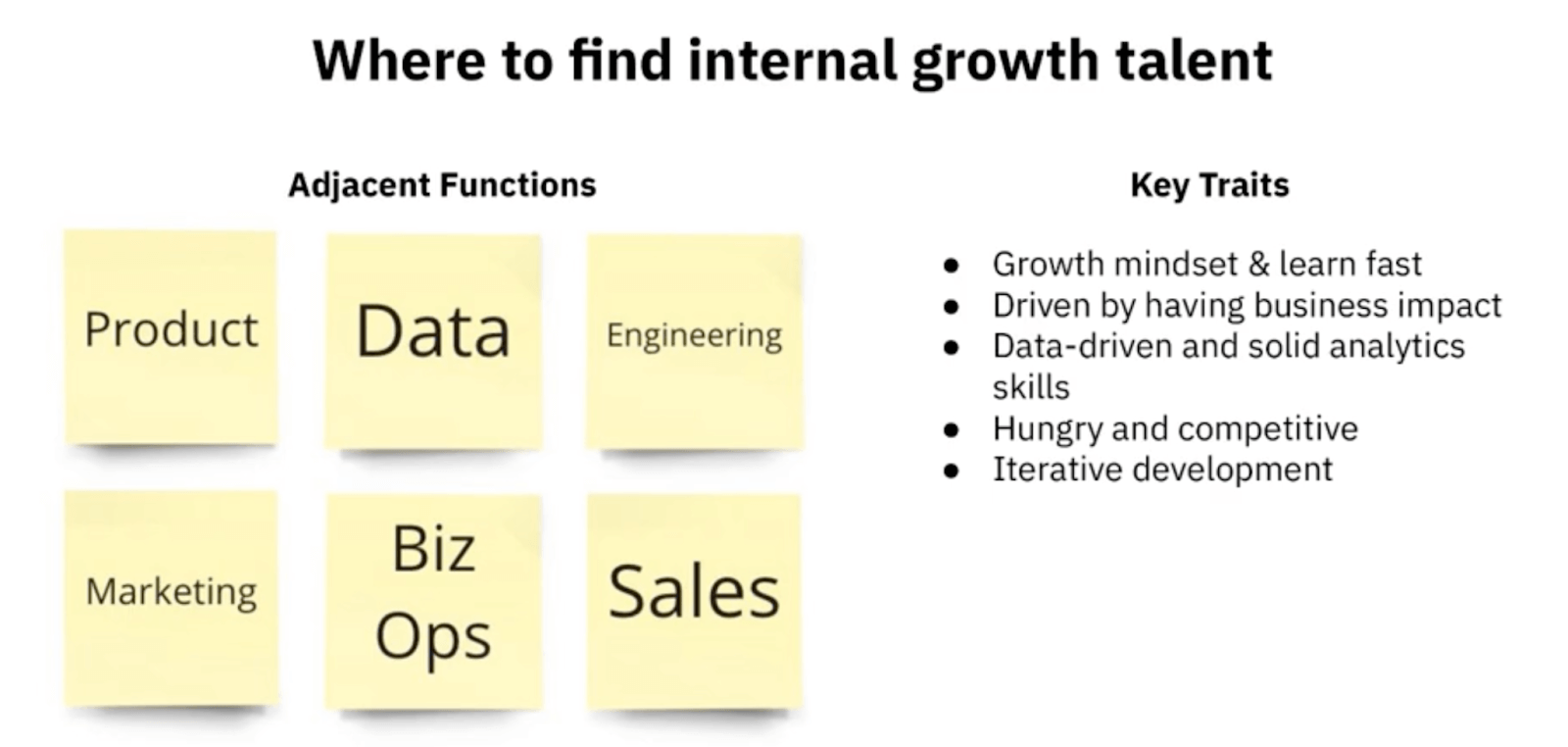
So in terms of function, anyone who comes from product management, data, engineering, marketing, BizOps, and sales could be a great fit because they already have part of the competency that’s required for someone to succeed in this domain.
Some of the key personality traits I look for is whether someone has the type of growth mindset to learn really fast. Even though growth might be a brand new domain for them, they're willing to roll up their sleeves, learn by doing, and seek outside resources to learn about some of the case studies and frameworks.
If they're hungry and competitive. Sometimes I find that people coming from a military background or someone who was a former athlete could be a great fit for growth.
Being data-driven and having great analytic skills are super important. And this needs to be someone who cares about having a quantifiable business impact. Sometimes people coming from management consulting or investment banking backgrounds might be a good fit.
If you conclude after searching internally that you simply cannot find someone to do the job, you might have to hire externally. One of the resources that I’d recommend is Reforge.
As I mentioned before, it's a very solid network of top growth practitioners in the industry. In their community, you can find up-and-coming growth PMs who are rising in their career and exhibit a tremendous growth mindset, simply because they enrolled in this program.
This is such a close-knit industry. Once you get to know a single growth leader that you deeply admire, even if that person doesn't join your company, the chances are that person is connected to or already knows many people similar to them that you can network with as well.
So definitely leverage the private growth leader network because this is a very small circle and everyone knows each other.
This article is taken from a presentation given by Andrea Wang (Principal Product Manager for Growth at Amplitude) at the Chief Product Officer Festival in November 2022.



 Follow us on LinkedIn
Follow us on LinkedIn



